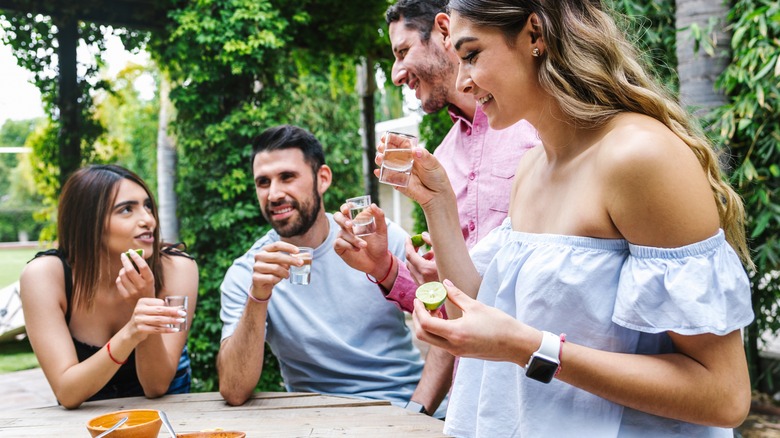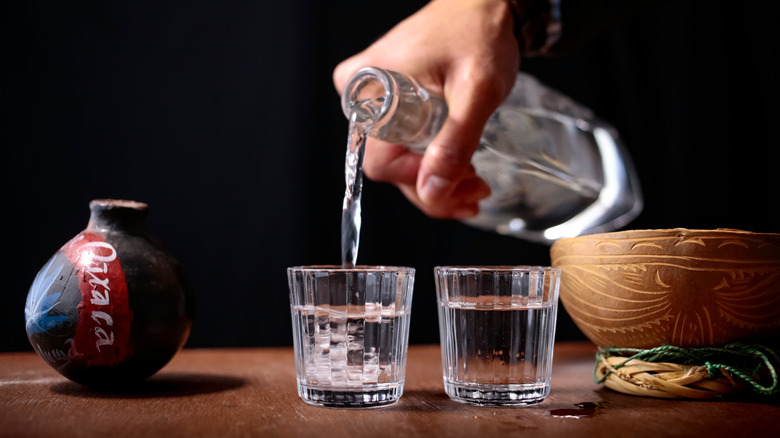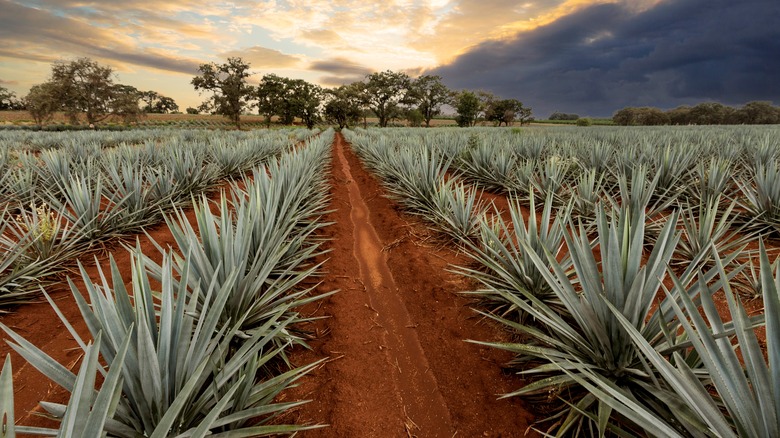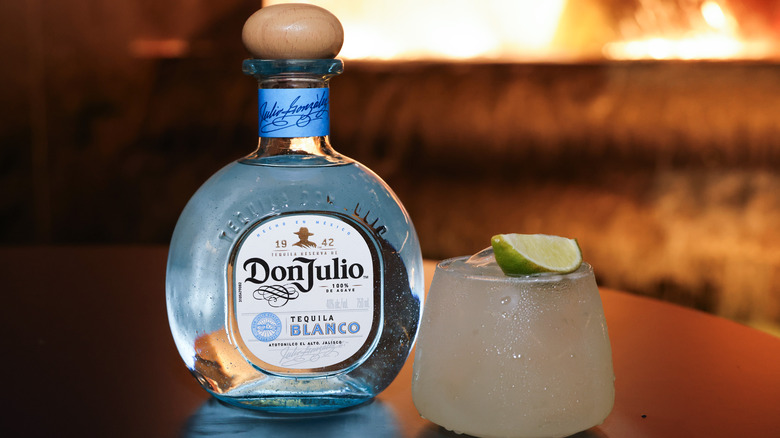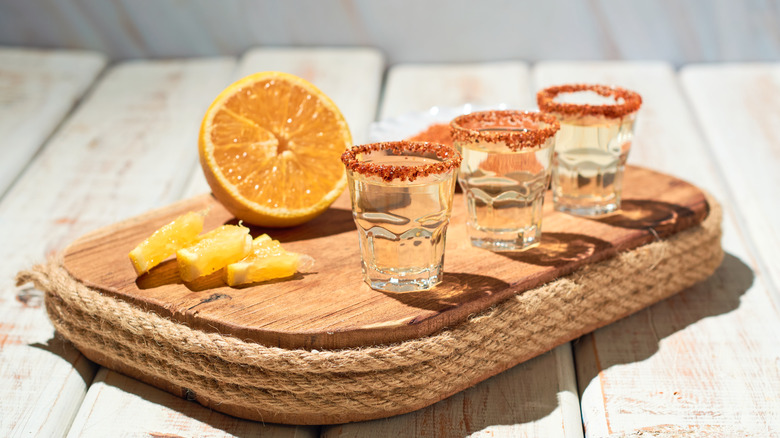How To Taste The Flavor Differences Between Mezcal And Tequila
Virtually all of Mexico's famed traditional liquors are derived from agave. This is true not only of tequila and mezcal — both of which are sourced from the distinctively spiny succulent — but also of regional specialties such as bacanora, raicilla, and sotol. Despite the similarities, however, all of these liquors have characteristic flavors that distinguish them from one another.
How is this possible? Well, just as wine is made from numerous grape varieties, Mexico's most famous liquors are made from a wide array of agave species. Mezcal alone, for example, can legally be made from over 50 different species of the agave plant, and many more species (166 in total) are found throughout Mexico. Tequila, by contrast, is made solely from Blue Weber agave. This fact accounts for some of the flavor differences between the two iconic spirits, but other aspects also come into play, from regional growing conditions to divergent production methods.
For aficionados of tequila and mezcal who'd like to become more knowledgeable about discerning these flavor differences, there are basic tasting notes that are helpful to know. Tequila, for instance, is often described as citrusy, peppery, or spicy — while mezcal is famously smoky. Tequilas, especially aged añejo tequilas, are noticeably smoother and sweeter than mezcal. But tasting notes can vary widely from bottle to bottle, so it's helpful to understand where these flavors are coming from in the first place.
Where mezcal gets its flavor
The most distinguishing characteristic of mezcal is its smoky flavor. The origin of this smokiness is in mezcal's roasting process, which traditionally takes place in underground pit ovens prior to milling, fermentation, and distillation. This is the defining flavor and the reason it is always possible to tell mezcal from tequila. However, as one becomes better acquainted with the spirit, it becomes easier to discern other notes. These are attributable to a variety of factors, including the specific agave species, as well as unique growing conditions, and artisanal production methods (over 95% of mezcals are produced in the Mezcal Artesanal category, according to Comercam).
Some agave species used for mezcal mature much more slowly than the five to seven years needed for tequila's Blue Weber — cinnamon- and pepper-tasting tepeztate agave, for example, is famously grown more than three decades before harvesting — but espadin (agave angustifolia), the variety that Comercam notes is used for over 81% of mezcals, matures within eight years.
The majority of mezcal is thus made from espadin agave plants grown in the Mexican state of Oaxaca (this state alone accounts for more than 91% of all mezcal, per Comercam), and produced using artisanal methods. So outside the smoky flavor associated with roasting, much of the flavor in mezcal is likely to come from espadin, and the terroir in Oaxaca, where high-elevation growing conditions are common. These flavors are a reflection of unique conditions, but earthy and herbaceous undertones are often noted, as are hints of flowers and fruit.
Where tequila gets its flavors
Terroir also matters when it comes to tequila. Jalisco is the traditional center of tequila production. Just as Oaxaca produces the overwhelming majority of mezcal, Jalisco is responsible for most tequila production. Blue Weber agave (aka agave tequilana) in Jalisco is largely cultivated in two areas, which range from 4,300 to more than 7,000 feet above sea level. These respective growing regions — the so-called lowlands and aptly named highlands — are each notable for their distinctive microclimates and flavors. Lowland Tequila Valley, for example, is famed for producing peppery and earthy tequilas while those that originate in the highlands of Los Altos are associated with sweeter, more floral flavors.
Production and aging methods also contribute to tequila's distinctive flavor compounds, which once learned, make the spirit easy to identify in blind tastings. Many of the fruity and nutty flavors associated with tequila, for instance, are the result of barrel aging for reposado (for two to 12 months), añejo (one to three years), and extra añejo (over three years) varieties. Savory and fruity flavor nuances can also be imparted during the fermentation and distillation processes, however, as can characteristic spicy notes.
The longer tequila is aged, the smoother and richer it's likely to be. Mezcal has similar aging guidelines, but it's exposed to far less barrel aging. Thus, tasting notes associated with aging typically indicate tequila.
How to taste tequila and mezcal
In order to discern flavor differences in tequila and mezcal, it helps to have an appreciation for proper tasting protocol, as well as a knowledge of traditional glassware. Mezcal, for example, is at its best in a vaso veladora, a Oaxacan style glass that originated as a repurposed candle holder. Caballitos ("little horses"), meanwhile, are the traditional Mexican vessel for tequila. These tall, thin shot glasses — which boast a wider mouth than base — have a history that dates back to the 19th century.
When tasting, start by assessing the color of your spirit. Unaged mezcals and tequilas are colorless — while those that have aged in wood barrels will have developed various levels of amber color. This color can also provide tasting clues since barrel-aged añejo and extra añejo spirits (a much rarer occurrence for mezcal than tequila) often have caramel or vanilla flavors. The next steps are exploring aroma and taste. For the former, inhale the aroma and see if you can detect some of the signature scents for the respective liquors. For the latter, try to confirm your appraisals. Smoky mezcals should be easy to identify via tasting while differentiating between spicy and herbal notes can also provide context clues.
Both spirits should be treated with respect in the sense that they should always be sipped. After the initial taste, however, try bigger sips, and swirl the liquor over your tongue. Repeat as necessary to evaluate complex finishing notes.
Pairing partners for tequila and mezcal
During the long history of tequila and mezcal production in Mexico, different cultural practices have evolved regarding the consumption of these spirits. Such practices often provide valuable tasting clues. Mezcal, for example, is often served with an orange wedge flavored with sal de gusano (worm salt). This traditional pairing dates back at least to the 1940s, and it's a wonderfully harmonious one. The combination of citrusy tang and earthy worm salt offers a perfect complement to mezcal's smokiness, while also highlighting the spirit's earthy, herbaceous notes. This shouldn't come as a surprise, of course, given that the maguey worms used for the salt are also sourced from agave plants.
Tequila, by contrast, was traditionally served with lime and salt. This practice began in the 19th century, and unlike the marriage of mezcal with oranges and worm salt, was originally intended not to elevate the flavors of the spirit, but to soften and subdue them. Its origin is actually attributable to the large amount of cheap tequila being produced at the time. The pairing soon became popular, however, and remained so, even as tequila quality has markedly improved.
Nowadays, it's not recommended. Instead, try pairing tequila with food. The best bet is to use the age of the tequila as a guide to complementary flavors. Older, smoother añejos, for example, are best with sweeter foods (think dessert tastings). Unaged blancos and lightly-aged reposados, meanwhile, complement citrusy and spicy flavors, respectively.

